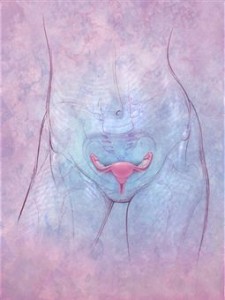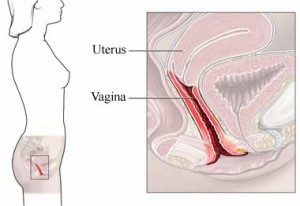Your vagina is a warm moist place, a lovely place.
Normally we grow a bacteria call lactobacillus in the vagina. This bacteria excretes a slight acid which prevents other bacteria from taking up residence
Stress can interfere with our immune system, as can grief, a poor diet (especially eating a lot of sugar, alcohol or simple carbohydrates).
All of this changes the internal environment which supports the growth of bacteria, fungus and parasites. These cause odor, itching and or irritation.
There are three groups of pathogens that cause vaginal infections. Following is a description of each and the treatment options.
 Bacteria
Bacteria
Bacterial Vaginosis (BV) is a combination of five bacteria that is the most common cause of vaginal infections. The main symptom of this infection is a foul or unpleasant odor and irritation/burning. Your vagina does not smell, so if you have an odor you may have an infection.
Treatment:
BV will often respond well to Tea Tree Oil Suppositories. DO NOT USE TEA TREE OIL DIRECTLY ON THE VAGINIA OR ON A TAMPON PLACED IN THE VAGINA. IT NEEDS TO BE DILUTED IN AN OIL SUPPOSITORY
- Another herbal approach is taken orally by mixing a tincture of herbs.
- Augmentin is a form of Penicillin that can be effective against BV. Its problem is that it is a systemic antibiotic where the problem is local and can be treated with local antibiotics.
- Metronidazole and its cousins. This is the most effective treatment for BV. The main pharmaceutical brand is called Metro-gel. A few years ago a client from Canada brought me a treatment she used. She said it worked much better that anything she found in the USA. It was a combination of Metronidazole and Clortimazole. I called our compounding pharmacy and they make it for us. I prefer this compounded combination which prevents a yeast infection following the antibiotic and is less expensive than the pharmaceutical. Vaginal metronidazole avoids most of the side effects of taking the antibiotic orally. However it is important to avoid alcohol while using it as it can cause nausea and vomiting. BV has become resistant to antibiotics by developing a capsule around itself. It is possible to disolve this capsule by placing a strong digestive enzyme such as Intenzyme Forte or Wobezyme in the vagina as you begin treatment with the antibiotic.
Prevention:
If you find you are prone to bacterial vaginosis infections, I find cranberry tablets, three three times a day can help prevent reoccurrences. Some women use an over the counter vaginal gel that keeps your maintains a normal vaginal ph. This encourages the growth of normal bacteria.
If you repeatedly get BV we should check your partner by collecting a fist morning urine sample. He urinates only the first spurt of urine into a clean container and brings it to the office. I spin the sample and take the sediment to look at the epithelial cells under the microscope. If your partner has this infection and you do not use condoms you may be reinoculated with each intercourse.
Group B Streptococcus.This is not the same as a strep throat. Is not associated with an odor and causes irritation and burning. Treatment is with an antibiotic cream called Cleocin. I have not found an herbal approache that is effective treating Group B Strep.
Lactobacilliosis
This is an over growth of the normal bacteria in your vagina. It can cause a burning sensation as it makes your vagina too acidic. Lactobacilliosis can be diagnosed by doing a wet prep. Looking under the microscope. It is treated with a one time inoculation of baking soda in water.
Fungus or yeast
We have 3 strains of yeast that infect the vagina:
- Candida Albacans,
- Trachta
- Gilbrata.
Symptoms:
Are of itching, sometimes mild and sometimes extreme; cottage cheese discharge and paper cut lesions on the folds of the vulva. Yeast does not cause a bad odor or burning. If you have these you don’t have yeast
Treatments:
- Boric acid and herbal capsules are designed to acidify the vagina so that yeast cannot grow. Many women find these capsules work well.
- Vaginal creams or gels that acidify the vagina
- Homeopathic vaginal creams or gels such as Yeast away.
- Yogurt in the vagina. This is also a way to acidify the vagina and for some women it works well. However I often see women who have been trying yogurt unsuccessfully.
- Tea tree oil vaginal suppositories. Again this works well for some women. TTO is mildly antifungal. It is better, in my experience for bacterial infections. Please DO NOT PUT TEA TREE OIL DIRECTLY IN YOUR VAGINA. It can burn your vaginal tissue. Use the suppositories.
- Vaginal creams that are available over the counter at pharmacies. I prefer Clortimazole as it covers all types of yeast. Myconizole (monistat) treats only Albacans. Creams come in 1 day, 3day and 7day options. The shorter the treatment the more likely you are to have a reoccurrence. I suggest doing 7 days
If you experience itching before or after your period which resolves on its own, you probably have a mild yeast infection. A good treatment for this is to use the 7 day treatment , 3 days before your flow and 4 days after your flow for 3 months.
If your yeast infection is chronic and even with the 7 day treatment it reoccurs we will need to check on things that make you more likely to develop yeast. An elevated blood sugar, use of hormonal contraceptives, menopausal low estrogen in the vagina, a diet high in sugar , alcohol and fruit are all things I evaluate.
Trichamonas.
Trichamonas is a single cell parasite that is sexually transmitted
Symptoms:
Include a very inflamed vagina and labia and a foul odor like spoiled meat
Treatment:
Metronidazole for 5 days. Metronidazole has cousins that some people prefer. We can use other antibiotics and they do not seem to work as well. Since Trich. can be in the urethra it really requires a systemic antibiotic to treat. I have not found an herbal approach that works with Trich.

Women who get frequent vaginal infection may:
- Not be treating the correct pathogen. Antifungals do nothing for bacterial infections as antibiotics do not help yeast infections. Antibiotics are specific to particular bacteria. If we do not know what is causing the infection we cannot treat it properly.
- Be resistant to the usual treatment
- Have a elevated blood sugar which elevated glycogen in the vagina and changes the vaginal environment.
- Lack estrogen in your vagina. Estrogen helps maintain a normal vaginal environment.
Irritation that is not an infection.
If you experience vaginal/vulvar irritation and your practitioner says you have normal vaginal bacteria, you may want to investigate Vulvodynia. You can find information about this condition thru the VP Foundation at www.thevpfoundation.org.
If you experience itching and your practitioner tells you that you have no yeast you may have Lichen Sclerosis Et Atrophicus. This is an auto immune condition that caused thickened white plaques on your vulva and around the anus. Our labia is pink, if you see areas that are white and dry you may have LS et A. The main symptom is itching. The treatment for this is either cortisone or testosterone cream to the effected skin. I prefer a compounded combination of cortisone and eurax which you apply to the effected skin until it returns to its normal pink.
Atrophic vaginitis.
With peri-menopause or menopause estrogen levels decrease. Under the influence of estrogens our vaginas are plush and thick with a web of blood vessels for support. When estrogen levels decrease the lining thins out. Many women experience no problems with this change. Some, however, may experience vaginal/vulvar irritation, vaginal discharge and or spotting, pain with intercourse, leaking of urine, and more frequent vaginal or urinary tract infections.
Treatment:
Estrogen to the vagina.
- I prefer Estriol vaginal cream as our bodies do not have many receptors for Estriol in the uterus and the breasts. For this reason we worry less about the risk of cancer from using Estriol
- Estradiol vaginal cream. This is a prescription from the pharmacy
- DHEA cream for women who cannot use estrogen because of clotting risk or cancer risk.
- Vit. E oil. Take a capsule of Vit. E, prick it with a pin and squeeze it onto you clean finger. Put it into your vagina just before lying down for the night. Recently there have been some Vit. E creams available from health food stores for vaginal comfort
- Testosterone cream. If your discomfort is in the vulvar area only the treatment is not estrogen, it is with testosterone. Vulvar tissue comes from the same tissue that becomes testicles so it responds to testosterone rather than estrogen
Vaginal and vulvar creams do absorb systemically. However since they are local first, we can use much smaller doses to accomplish our desired effect.
Even if you are on systemic HRT, you may need more estrogen or testosterone in your vulva/vagina than you do in the rest of your body to treat symptoms of menopause. I feel it makes more sense to put the hormone where you need it than to expose the whole body to potential side effects.
Vaginal health.
Douching is not a good idea, nor is it necessary unless you are treating a vaginal infection. Studies have shown that women who douche regularly experience more vaginal infections, abnormal paps and pelvic inflammatory disease. Your vagina is elegantly designed and cleans itself. You sweat and shed skin cells which migrate down to the opening. When you urinate this discharge is washed away.
Normal healthy vaginal discharge has no odor. If you have an unpleasant odor, with or without irritation, you probably have a vaginal infection and should see your practitioner to find out the cause. For an appointment contact us